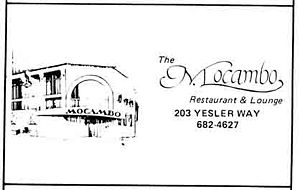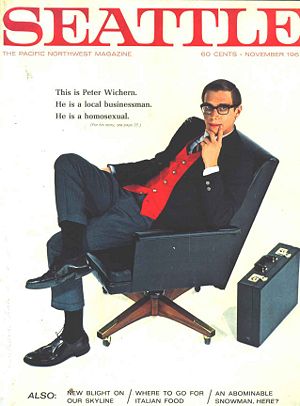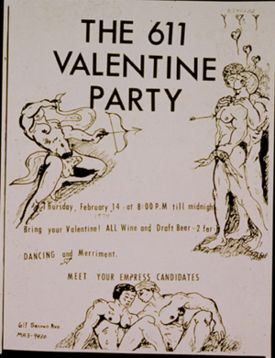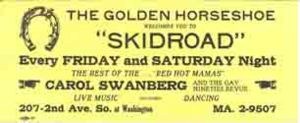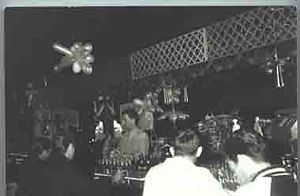Difference between revisions of "1960s - Pioneer Square"
The NWLGHMP (talk | contribs) |
m (Protected "1960s - Pioneer Square" [edit=sysop:move=sysop]) |
||
| (15 intermediate revisions by one other user not shown) | |||
| Line 1: | Line 1: | ||
'''1960s - Pioneer Square''' | '''1960s - Pioneer Square''' | ||
| − | + | [[Image:mocambo-menu.jpg|300px|right]] | |
Like many of the bars and taverns in Pioneer Square, the Mocambo Restaurant and Lounge was far more than just a lounge. The Mocambo, open from 1951 to 1978, served a vital role as a meeting place for early gay organizations. The Queen City Business Guild, an organization of bar owners that would eventually become today’s Greater Seattle Business Association, as well as the United Ebony Council, a black gay male organization founded in 1975, and part of the Court of Seattle with its empresses and royalty, both used the Mocambo for early organizational meetings. | Like many of the bars and taverns in Pioneer Square, the Mocambo Restaurant and Lounge was far more than just a lounge. The Mocambo, open from 1951 to 1978, served a vital role as a meeting place for early gay organizations. The Queen City Business Guild, an organization of bar owners that would eventually become today’s Greater Seattle Business Association, as well as the United Ebony Council, a black gay male organization founded in 1975, and part of the Court of Seattle with its empresses and royalty, both used the Mocambo for early organizational meetings. | ||
| − | + | <BR><BR> | |
Another important organization that met regularly at the Mocambo during the late 1960s was the Dorian Society. The [[Dorian Society]] was Seattle’s early homophile organization, as most gay groups were called during this era. In addition to traditional educational efforts such as a newsletter, the Dorian Society had a speakers bureau to speak in Seattle public schools, appeared on radio programs, led tours of gay bars for a program called Urban Plunge, and hosted drag balls. | Another important organization that met regularly at the Mocambo during the late 1960s was the Dorian Society. The [[Dorian Society]] was Seattle’s early homophile organization, as most gay groups were called during this era. In addition to traditional educational efforts such as a newsletter, the Dorian Society had a speakers bureau to speak in Seattle public schools, appeared on radio programs, led tours of gay bars for a program called Urban Plunge, and hosted drag balls. | ||
| + | <div style="margin-left: 600px">[[Image:Peter Wichern.jpg|right|300px|Sample Caption|]]</div><BR> | ||
| + | In 1967, Dorian Society member Peter Wichern appeared on the cover of Seattle magazine, with a caption reading: | ||
| + | :This is Peter Wichern. | ||
| + | :He is a local businessman. | ||
| + | :He is a homosexual. | ||
| + | This striking image is a reminder that the work of homophile organizations like the Dorian Society and the Third Name Society (a women’s organization) were already making significant efforts toward gay and lesbian visibility. | ||
| + | [To read more about Peter Wichern and his life after the Seattle Magazine interview follow the link to: "Peter Wichern, the man on the cover."[http://home.earthlink.net/~ruthpett/lgbthistorynw/seamag.htm]] | ||
| + | <BR><BR> | ||
| + | The Dorian Society assisted Dr. Robert Deisher in establishing Seattle Counseling Services for Sexual Minorities. The Seattle Counseling Services for Sexual Minorities, established in 1969, was the first gay-run counseling service for gays in the country. | ||
| − | + | During this period there were other indicators of increased visibility. MacIver Wells opened the 611 Tavern just before the 1962 World’s Fair to capitalize on the flood of tourists that washed through Seattle. The interior of the 611 was very conscious about serving a gay clientele. The décor was designed to provide maximum visibility for patrons - including mirrors on the wall. Like most bars in Seattle both gay and straight alike, it was subject to the “blue laws” preventing activities ranging from patrons holding drinks while standing up, or the number of chairs at the bar. | |
| − | |||
| − | |||
| − | + | In addition to the restrictive blue laws, many gay bars—including the 611—were also part of the police payoff system. By paying off police officers, bar owners could ensure that their patrons would be left alone. However, this wasn’t always the case – police and unfriendly straight people often harassed patrons nonetheless. By the late 1960s, the payoff system would come to a head, in part because of MacIver Wells’ efforts. | |
| + | <BR><BR> | ||
| + | Despite harassment and the payoff system, however, bars and taverns were the birthplace of the gay and lesbian community. Many political organizations and service agencies held their first meetings in Pioneer Square bars, and perhaps most importantly, long-term friendships and relationships began in places like the 611, as Bob, an oral history interviewee, recalls: | ||
| + | <div style="margin-right: 600px">[[Image:611flyer.jpg|left|275px|Sample Caption|]]</div><BR> | ||
| + | :Bob: “The 611 was not the first gay bar that I ‘frequented’, but on July 11, 1970, it was the place where I met the man that is my partner in life. That was 26 years ago. (I use the term ‘frequented’ because that was the popular term used by the police, the military and the general press to describe businesses or locations ‘patronized by homosexuals.’) I remember the bar from 1962 in the summer of the Seattle’s World Fair, which surely provided a lot of tourist business. I can recall my first visit—I went with a much older friend and we sat on the right side at the entrance near the window. There was lots of red and black in the decor. On the first night I recognized a fellow student from UW [University of Washington]. It was quite a special feeling and I knew I would be back. No doubt the 611 has served as a meeting place for thousands of gay people, some of whom have become lasting friends and even life partners, as in my case.” | ||
| + | <BR><BR><BR> | ||
| + | [[Image:goldenhorshoead.jpg|300px|right]] [[Image:goldenhorshoe-Interior.jpg|300px|right]] | ||
| + | In the early 1960s, the Golden Horseshoe became Seattle's first regular-hours bar where men could dance openly with men. In exchange for this "privilege," the owners had to pay the police $50 per week, plus $15 a night for a cop to monitor the door on Fridays and Saturdays. Police pay-offs were common in this time period, a means of fending off harassment and keeping the bars open. In the late '60s, a group of bar owners joined forces with the FBI to expose the pay-off system; scores of Seattle police were dismissed and some were sent to prison. | ||
| − | |||
| − | |||
| − | |||
| − | |||
| − | |||
| − | |||
| − | |||
| − | |||
| − | |||
| − | |||
| − | |||
Read first hand accounts, [[1950s- 60s Pioneer Square - Oral Histories]]. | Read first hand accounts, [[1950s- 60s Pioneer Square - Oral Histories]]. | ||
<BR><BR> | <BR><BR> | ||
| − | [[Seattle, WA: Queen City Comes Out: Exploring Seattle's Lesbian and Gay History]] | + | [[Seattle, WA: Queen City Comes Out: Exploring Seattle's Lesbian and Gay History]] |
| + | <BR><BR> | ||
| + | <small>''All content of this page copyrighted by NWLGHMP.''</small> <comments /> | ||
Latest revision as of 11:02, 1 May 2010
1960s - Pioneer Square
Like many of the bars and taverns in Pioneer Square, the Mocambo Restaurant and Lounge was far more than just a lounge. The Mocambo, open from 1951 to 1978, served a vital role as a meeting place for early gay organizations. The Queen City Business Guild, an organization of bar owners that would eventually become today’s Greater Seattle Business Association, as well as the United Ebony Council, a black gay male organization founded in 1975, and part of the Court of Seattle with its empresses and royalty, both used the Mocambo for early organizational meetings.
Another important organization that met regularly at the Mocambo during the late 1960s was the Dorian Society. The Dorian Society was Seattle’s early homophile organization, as most gay groups were called during this era. In addition to traditional educational efforts such as a newsletter, the Dorian Society had a speakers bureau to speak in Seattle public schools, appeared on radio programs, led tours of gay bars for a program called Urban Plunge, and hosted drag balls.
In 1967, Dorian Society member Peter Wichern appeared on the cover of Seattle magazine, with a caption reading:
- This is Peter Wichern.
- He is a local businessman.
- He is a homosexual.
This striking image is a reminder that the work of homophile organizations like the Dorian Society and the Third Name Society (a women’s organization) were already making significant efforts toward gay and lesbian visibility.
[To read more about Peter Wichern and his life after the Seattle Magazine interview follow the link to: "Peter Wichern, the man on the cover."[1]]
The Dorian Society assisted Dr. Robert Deisher in establishing Seattle Counseling Services for Sexual Minorities. The Seattle Counseling Services for Sexual Minorities, established in 1969, was the first gay-run counseling service for gays in the country.
During this period there were other indicators of increased visibility. MacIver Wells opened the 611 Tavern just before the 1962 World’s Fair to capitalize on the flood of tourists that washed through Seattle. The interior of the 611 was very conscious about serving a gay clientele. The décor was designed to provide maximum visibility for patrons - including mirrors on the wall. Like most bars in Seattle both gay and straight alike, it was subject to the “blue laws” preventing activities ranging from patrons holding drinks while standing up, or the number of chairs at the bar.
In addition to the restrictive blue laws, many gay bars—including the 611—were also part of the police payoff system. By paying off police officers, bar owners could ensure that their patrons would be left alone. However, this wasn’t always the case – police and unfriendly straight people often harassed patrons nonetheless. By the late 1960s, the payoff system would come to a head, in part because of MacIver Wells’ efforts.
Despite harassment and the payoff system, however, bars and taverns were the birthplace of the gay and lesbian community. Many political organizations and service agencies held their first meetings in Pioneer Square bars, and perhaps most importantly, long-term friendships and relationships began in places like the 611, as Bob, an oral history interviewee, recalls:
- Bob: “The 611 was not the first gay bar that I ‘frequented’, but on July 11, 1970, it was the place where I met the man that is my partner in life. That was 26 years ago. (I use the term ‘frequented’ because that was the popular term used by the police, the military and the general press to describe businesses or locations ‘patronized by homosexuals.’) I remember the bar from 1962 in the summer of the Seattle’s World Fair, which surely provided a lot of tourist business. I can recall my first visit—I went with a much older friend and we sat on the right side at the entrance near the window. There was lots of red and black in the decor. On the first night I recognized a fellow student from UW [University of Washington]. It was quite a special feeling and I knew I would be back. No doubt the 611 has served as a meeting place for thousands of gay people, some of whom have become lasting friends and even life partners, as in my case.”
In the early 1960s, the Golden Horseshoe became Seattle's first regular-hours bar where men could dance openly with men. In exchange for this "privilege," the owners had to pay the police $50 per week, plus $15 a night for a cop to monitor the door on Fridays and Saturdays. Police pay-offs were common in this time period, a means of fending off harassment and keeping the bars open. In the late '60s, a group of bar owners joined forces with the FBI to expose the pay-off system; scores of Seattle police were dismissed and some were sent to prison.
Read first hand accounts, 1950s- 60s Pioneer Square - Oral Histories.
Seattle, WA: Queen City Comes Out: Exploring Seattle's Lesbian and Gay History
All content of this page copyrighted by NWLGHMP. <comments />
